In recent years, we have all shifted to ways of working and living that rely more on the convenience of online shopping. E-commerce has flourished and people love it.
There is very little that you can’t get online and have delivered within a couple of hours, and that kind of convenience is hard for any shopper to resist!
Selling FMCG products online is challenging, as they have huge sales volumes, and narrow profit margins, which makes them less than ideal for e-commerce. And that is before you take perishable products into consideration.
So, how do FMCG (Fast-Moving Consumer Goods) companies keep up with this shift towards e-commerce? How can they adapt their marketing to stay competitive?
Today, we’re covering how to get the most out of your FMCG marketing strategy and what you need to do to create a successful digital marketing strategy; with detailed explanations of key concepts and ideas, real-life examples, and a checklist to help you boost your sales.
Ready?
Let’s dive into it!
Before we get into how to market your Fast-Moving Consumer Goods (FMCGs), let’s quickly cover what they are, specifically:
Fast-Moving Consumer Goods, also known as Consumer Packaged Goods, are products with a short shelf-life, like food and drinks, or that consumers use regularly and need to purchase often, like toiletries, cleaning supplies and self-care products. They are usually low-cost items, with narrow profit margins but high sales volumes.
FMCGs are both simple and challenging to sell, as there is a massive market for them; however, due to this significant demand, there is a lot of competition too!
The market is always changing, and what works this year might not work the next, making it imperative to stay on top of new FMCG marketing trends. If you’d like to know what the projections for the FMCG industry are in the next few years, watch this video by McKinsey & Company:
Summary: What Does FMCG Mean?
FMCG is the acronym for Fast-moving Consumer Goods, which are also known as Consumer Packaged Goods (CPGs). They are high-demand products with a short shelf life, and they are generally inexpensive, with low-profit margins and high sales volumes. FMCG examples include packaged foods, beverages, toiletries and household cleaning products that are used and bought frequently.
When it comes to an FMCG marketing strategy, there are a lot of opportunities for success. The market is worth over $672 billion is projected to grow to $901 billion by the end of 2027!
The nature of FMCG products means that loyal customers will purchase your goods frequently, sometimes weekly or even daily. FMCGs include the day to day essentials that every household uses, across almost all demographics.
As such, there will always be buyers in need of the products you’re selling and even in times of economic hardship, they will still need those products.
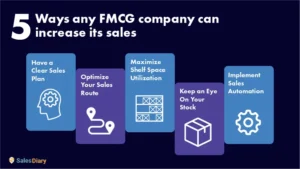
However, there are also a number of challenges that come alongside the great opportunities.
Firstly, the high demand for these products has drawn many companies to enter the industry, making the market a very competitive one.
With so many options for consumers to choose from, you don’t have the luxury of a captive consumer audience, and it can be challenging to attract customers to your particular product.
Furthermore, Fast-Moving Consumer Goods are commodities, and customer loyalty can be challenging to acquire as lower prices, sales, and discounts can shift buying habits.
In addition, with most FMCG companies working on a global scale, or at least a country one, the needs of different regions must be taken into account in order to be successful.
But if you can navigate and overcome the challenges of the industry, and you market your brand and your products well, you’ll have a vastly profitable company on your hands.
Summary: FMCG Marketing – Opportunities and Challenges
The FMCG industry is large and profitable, with a value of over $672 billion, projected increase to $901 billion by 2027. FMCGs include essential items for which there is a high and consistent demand.
However, FMCG industry is extremely competitive, and products commodities, and acquiring customer loyalty can be difficult as lower prices, sales, and discounts can shift buying habits.
The first, and arguably, the most important thing to do when marketing any company or product is to start with a social media strategy. And this is no less true for FMCG companies.
A social media presence allows FMCG brands to share information about their products and create communities around their brands. This is particularly important for FMCG companies as they can have trouble standing out from the competition.
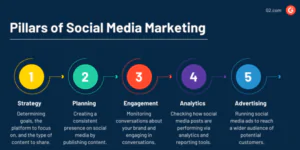
You can create brand accounts for various social media platforms like Reddit, YouTube, TikTok, Instagram, Discord, and Twitter; each of which will have a different strategy to optimize the platform for your marketing needs.
And, of course, the added benefit of online exposure is the increase in sales and website traffic.
You can also make use of social media and your FMCG brand to run various community-related events to drive both engagement and brand awareness.
For example, you can run quizzes about your brand or product, set up a poll to learn about what your customers want to see more of or run a giveaway.
Any of these will help you stand out from other similar companies, making a name for your brand in the industry.
Another great marketing strategy to drive sales and increase customer satisfaction is content marketing. This can be in the form of a weekly blog, YouTube videos, articles and how-to guides, informational videos, and product drops.
So that clients know what to expect from your FMCG company, you need to make sure that the content you put out is relevant, helpful, and in line with the tone and style of your brand identity.
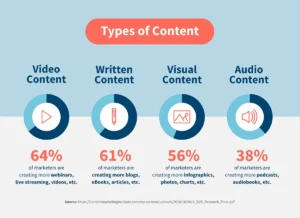
As we’ve already mentioned throughout this article, customers buying consumables are not starved for choice, and as such, they need to have a good experience with your brand. If they don’t, they’ll have no problem finding a brand that has a customer-centric strategy instead.
Therefore, the “Customer Experience” has never been more critical, and 67% of consumers say that they’d rather pay more for a better experience, while 80% of consumers agree that the experience a company offers is just as crucial as its products or services.
With social media content on the rise, influencers are gaining more and more sway over the audiences that follow them. And what better way to stand out from the crowd than to have an influencer review and promote your product?
Not only does this increase awareness for your brand, but it also boosts something else that might be more important – your social proof.
Moreover, influencers add a level of authenticity to the product they are promoting and, thereby, to your brand and company as a whole, something that FMCG companies, in particular, need to be successful.
User-generated content is one of the easiest and most affordable forms of promotion, and what’s more, it’s highly effective.
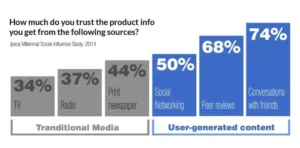
Your FMCG company can encourage customers to create content for you by hosting giveaways, competitions, and community-wide events. For example, hosting a competition to see who can use your product in the most creative way and rewarding them with a gift basket or voucher
Once the UGC has been created, you can share and repost it. This makes your brand more relatable, gets you involved with the community, and gives your product and company more exposure.
If you’re a brick and mortar store, a website is essential. A good website is a valuable tool for any company, but even more so for FMCG businesses. Your website is a place to provide information about all your products, give insight into your company and employees, and direct traffic to your social media accounts and your shopping app or online store if you have one.
You want to have as much of an online presence as possible, and a website can help significantly with that. Even just having your trading hours, contact information and physical address easily accessible is important, so claim that Google business listing and have a good website for it to direct people to.
An online store isn’t strictly necessary for a Fast-Moving Consumer Goods company; however, it is one of the best ways to increase sales.
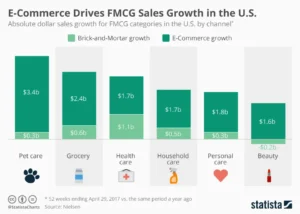
An eCommerce site allows interested customers to browse your products all in one place and see the ingredients and prices of said products.
Even if the interested individual doesn’t make a purchase through the online site, they’ll be more likely to buy it in a brick-and-mortar store if the information about your goods is readily available.
A shopping app for your FMCG store or brand is another way to get in on the e-commerce action, directly from your a brick and mortar stores. Convenience is key and when we can buy so much online, so easily, it’s only natural to want to get your home essentials online too.
If you have an app and offer delivery in the vicinity of your store, you’re able to offer your customers a much more convenient shopping experience.
FMCG companies can supplement their marketing efforts with paid advertising, the most popular networks being Google Ads, Instagram Ads, and Facebook Ads.
Campaigns on social media can be used to market products, raise brand awareness, and generate leads. Therefore, FMCG companies can reach a larger audience by using paid advertising.
Moreover, paid advertisements, once optimized, offer precise targeting and low costs.
Automated emails are an excellent way to persuade a customer. By creating customized action-triggered emails, you can communicate with your customers more effectively and assist them in completing a purchase. Moreover, these emails allow you to retarget customers who have previously purchased from you.
For example, when a customer first signs up, an email will be sent welcoming them. If a customer signs up and then adds an item to their online cart but does not check out, another email will be sent to remind them to complete their purchase.
A company’s online reputation can be one of the most critical things potential customers consider before purchasing. And as such, managing your online reputation is absolutely vital.
For example, responding to both positive and negative reviews on your online store can be a great way to reinforce positive reviews and mitigate the fallout of negative ones.
Furthermore, if you want to go one step further, you can search for threads about your products on online forums and do the same as above.
Summary: 11 FMCG Marketing Strategies for 2024
Who Gives A Crap is an Australian-based toilet paper company focused on environmentalism and global sustainability. Through humor and honesty, they have created a loyal community that engages with them both online and offline.
For example, their website is filled with their sense of humor and their mission statement: providing sanitation facilities to the billions of people who live without them.
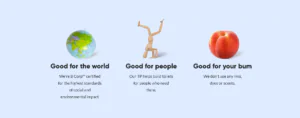
Due to their brilliant marketing efforts, Who Gives a Crap has become so much more than your standard FMCG company; they have become a culturally-wide example of how to stand out and make a name for yourself as a Fast-Moving Consumer Goods company—and are one of the best FMCG marketing examples out there.
Notably, Who Gives a Crap is available online and you can buy it from anywhere in the world, making it an FMCG e-commerce product, and showing the value of FMCG brands going online as much as possible.
Bodyform is a women’s health company that provides more than just personal care products; it also serves as a forum and source of information for women to discuss reproductive health issues and challenges.
In September 2021, Bodyform launched the Me and My Period campaign on Instagram to provide a safe space for their community to share their experiences. You can find a wealth of insightful user-generated content by searching the hashtag #meandmyperiod.

By encouraging openness and normalizing painful and unpleasant reproductive processes, Bodyform promotes authenticity and trust. Moreover, this campaign serves to help them describe the issues and pain points that their brand and product aim to address.
This approach to their social media marketing has been hugely successful, and gained impressive traction and valuable user generated content in the process. Bodyform has managed to make an FMCG product that no one really wants to talk about into a topic of conversation, gaining huge brand awareness in the process.
Dove’s newest campaign, #nodigitaldistortion, is part of its ongoing effort to promote body positivity and self-esteem. This campaign aims to alleviate social media’s stress on its users, particularly young people.

Dove encourages its community to have “The Selfie Talk” with the young people in their lives by using the “Confidence Kit” it provides as a communication resource. Dove’s extensive campaign features celebrities such as Lizzo and Shonda Rhimes discussing what it means to have a healthy image. They then invite their social network members to comment on #nodigitaldistortion.
Dove promotes the campaign on its active social media platforms, including Facebook, Twitter, and Instagram. The hashtag #nodigitaldistortion appears in over 1,000 Instagram posts, and #theselfietalk appears in hundreds of Twitter conversations.
Using social media, engaging consumers and spotlighting the brand’s values instead of the products directly, Dove was able to make basic personal care products relevant and topical. This is an example many FMCG brands and stores can learn from.
Traditionally the focus of FMCG marketing has focused on things like value-for-money, convenience and wholesome-healthy-family content. By focusing on the brands values, and tapping into a highly topical and relevant social issue, Dove managed to build a successful campaign around who they are rather than what they offer.
Humanizing your brand, emphasizing how your values align with your customer’s values and creating an emotional connection is highly valuable, especially if your brand is not that well known yet.
Summary: 3 Great FMCG Marketing Examples
And there you have it—everything you need to know about creating an FMCG marketing strategy.
This article has covered the steps and strategies you’ll need to take in order for your Fast-Moving Consumer Goods company to be successful. Moreover, we’ve covered three real-life FMCG marketing examples to give you a better idea of what to do and how to market your company.
However, due to the complicated nature of how FMCG companies work and how challenging they can be to market, sometimes it’s just easier to use an FMCG marketing agency. Or if you’re really serious about doing it yourself and you’re up for the challenge, looking into FMCG marketing courses might be the best choice for you.
Either way, this article has laid the groundwork for what comes next—lots and lots of marketing.
So what are you waiting for?
Get to it!
FMCG stands for Fast-moving Consumer Goods, also known as Consumer Packaged Goods (CPGs), are products with a short shelf life, like food and drinks, or that consumers use regularly and need to purchase often, like cleaning supplies and self-care products. They are generally inexpensive items, with low-profit margins, but very high sales volumes. Read the full guide to learn more about FMCG products and how to successfully use FMCG marketing for your business. Customized FMCG marketing strategies are essential to effectively advertise FMCG products and establish market authority in an exceptionally crowded and competitive space. Read the full guide to learn more about FMCG marketing, why it is so important and the best tactics to use. Fast-moving goods (FMCG) are consumer goods that sell quickly and at a low price. Packaged foods, drinks, toiletries, candy, cosmetics, over-the-counter medications, dry goods, and other consumables are examples of non-durable household items also known as FMCGs. Read the full guide to learn more about FMCGs and the best FMCG marketing methods to use. Frequently Asked Questions
What is FMCG?
Why is marketing important for FMCG?
What are some examples of FMCG?
HotJar: Understanding customer experience
V12 Data: 25 Stats on Consumer Shopping Trends | 2022
Investopedia: Consumer Packaged Goods (CPG): What They Are vs. Durable Goods
ImarcGroup: FMCG Packaging Market: Global Industry Trends, Share, Size, Growth, Opportunity and Forecast 2024-2032